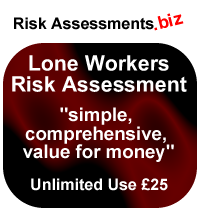|
||||||||
| Home » Lone Workers | ||||||||
|
Lone Workers Risk Assessments
Working Alone It is not illegal to allow workers to work alone but the Management of Health and Safety at Work Regulations requires you to consider any additional risks that working alone may pose to your employees or any one else affected by your work. Establishing a healthy and safe working environment for lone workers can be different to organising the health and safety of other employees. Employers need to know the law and standards that apply to their work activities, and then assess whether they can meet those legal obligations for people working alone. Lone workers face particular problems and are particularly at risk in the event of an emergency. When conducting risk assessments, the position of the lone worker should be particularly considered. Additional ConsiderationsThe HSE point to the following additional considerations:
Supervision Supervision – even from a distance - can help to ensure that employees understand the risks associated with their work and that the necessary health and safety precautions are carried out. Supervisors can also provide guidance in situations where there is uncertainty. Supervision of health and safety can often be carried out when checking the progress and quality of the work. This may take the form of periodic site visits combined with discussions in which health and safety issues are raised. The extent of supervision required depends on the risks involved and the ability of the lone worker to identify and handle health and safety issues. Employees new to a job, undergoing training, doing a job that presents special risks, or dealing with new situations may need to be accompanied at first. The level of supervision required is a management decision, which should be based on the findings of a risk assessment: the higher the risk, the greater the level of supervision required. It should not be left to individuals to decide whether they require assistance. Procedures must be put in place to monitor lone workers to help keep them healthy and safe. These may include:
Accidents and Emergencies Lone workers should be capable of responding correctly to emergencies. It is the employer’s responsibility when conducting the risk assessment to identify foreseeable events and to inform workers of any danger areas or risks. Emergency procedures should be established and employees trained in them, including lone workers who must understand what they are to do in the event of an emergency. They should have access to adequate first-aid facilities and mobile workers should carry a first-aid kit suitable for treating minor injuries. Occasionally, risk assessment may indicate that lone workers need first aid-training. Additional Control measures for lone workers may be necessary – for example, a particular task may be designated a two-man job or limited to experienced workers. Such control measures may include additional instruction, training, supervision, protective equipment etc. It is not enough to specify what control measures are to be in place, it is still the employers responsibility to ensure that the control measures are being followed and this also applies to lone workers. Employers should take steps to check that control measures are used and review the risk assessment from time to time to ensure it is still adequate. When risk assessment shows that it is not possible for the work to be done safely by a lone worker, arrangements for providing help or back-up should be put in place. Where a lone worker is working at another employer's workplace, that employer should inform the lone worker's employer of any risks and the control measures that should be taken. This helps the lone worker's employer to assess the risks. Contact us to conduct a lone worker risk assessment If this free information was useful, please recommend us or like us on our Facebook Page. Additional Reading:
|
 |
|||||||
